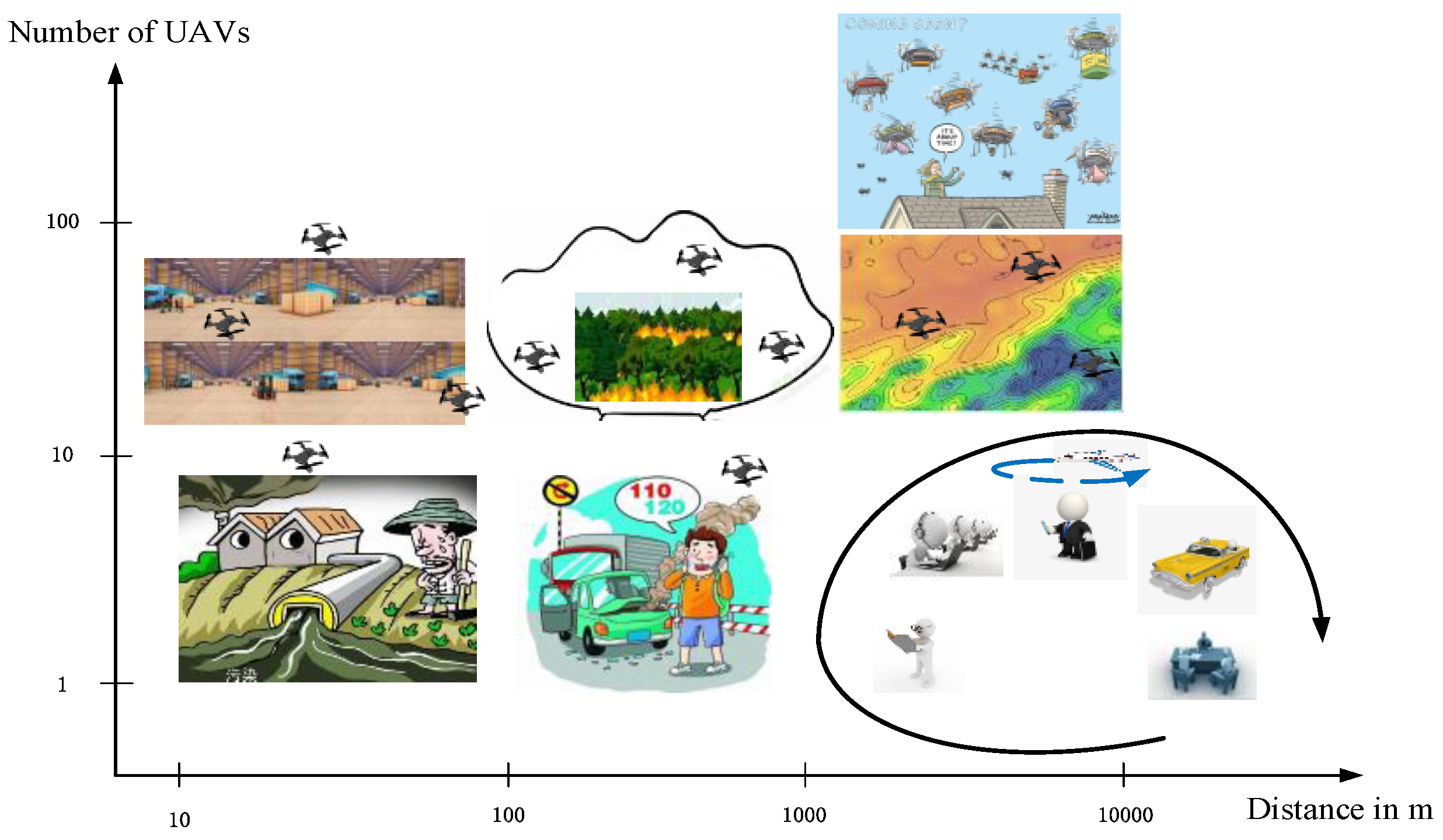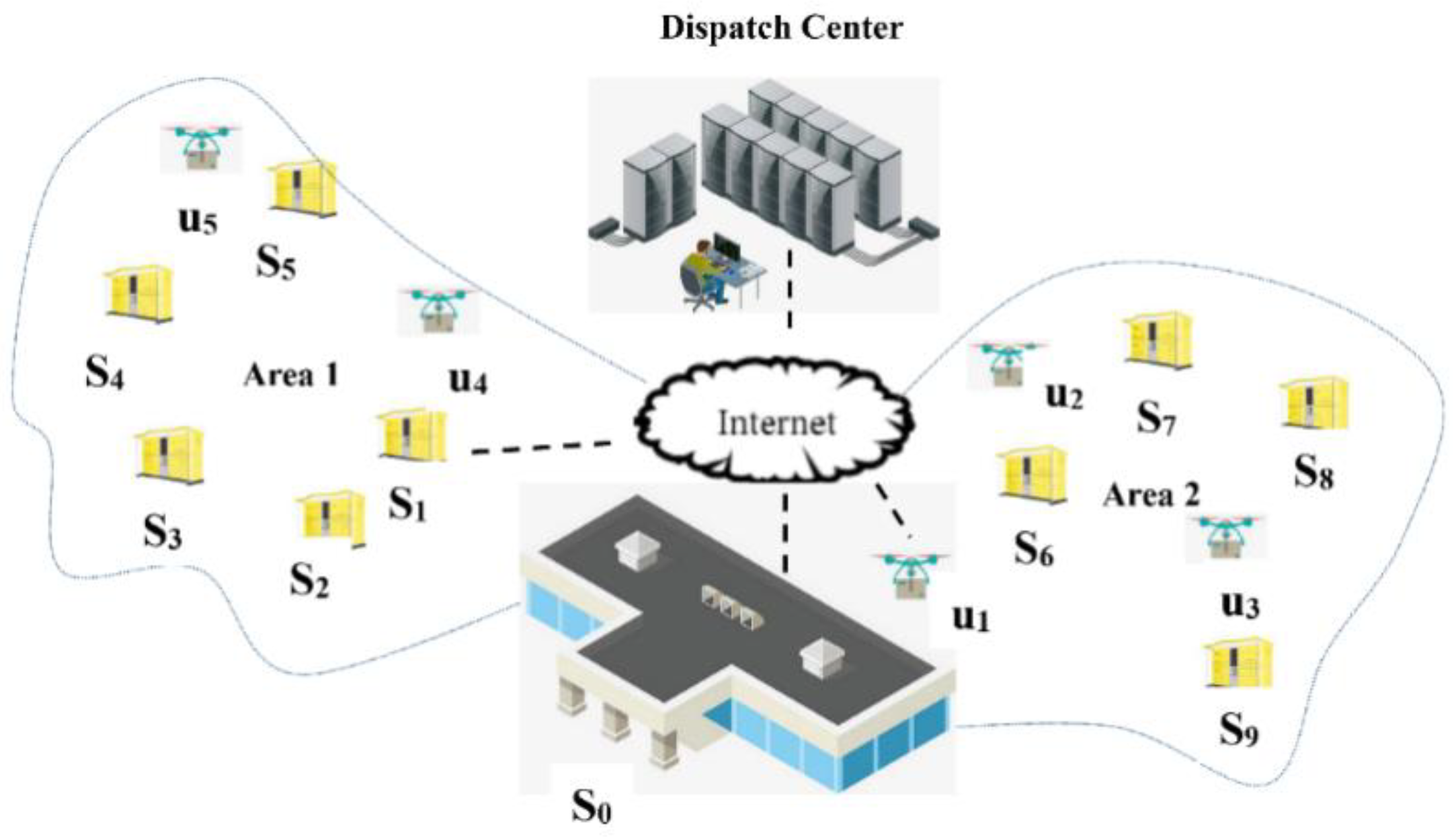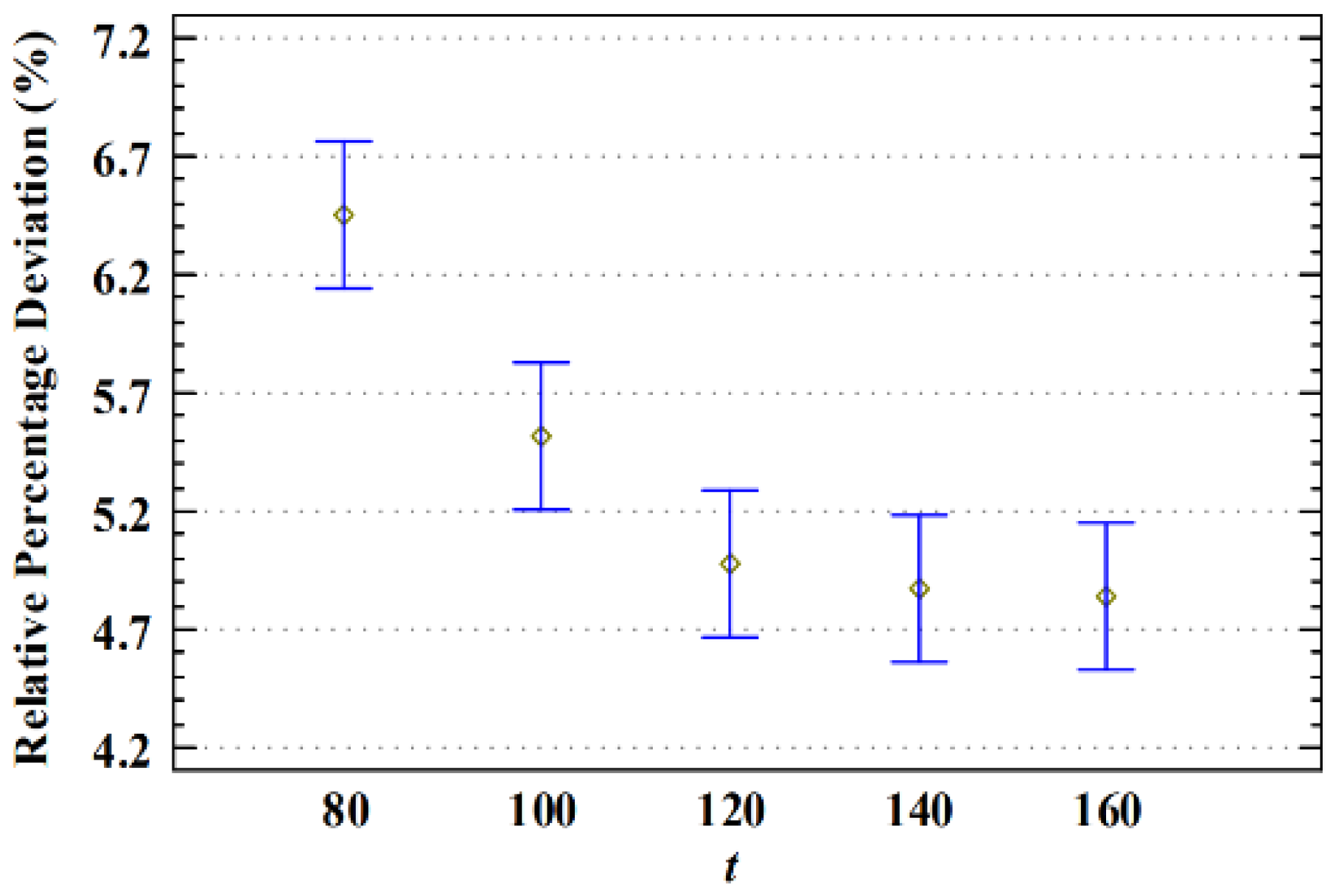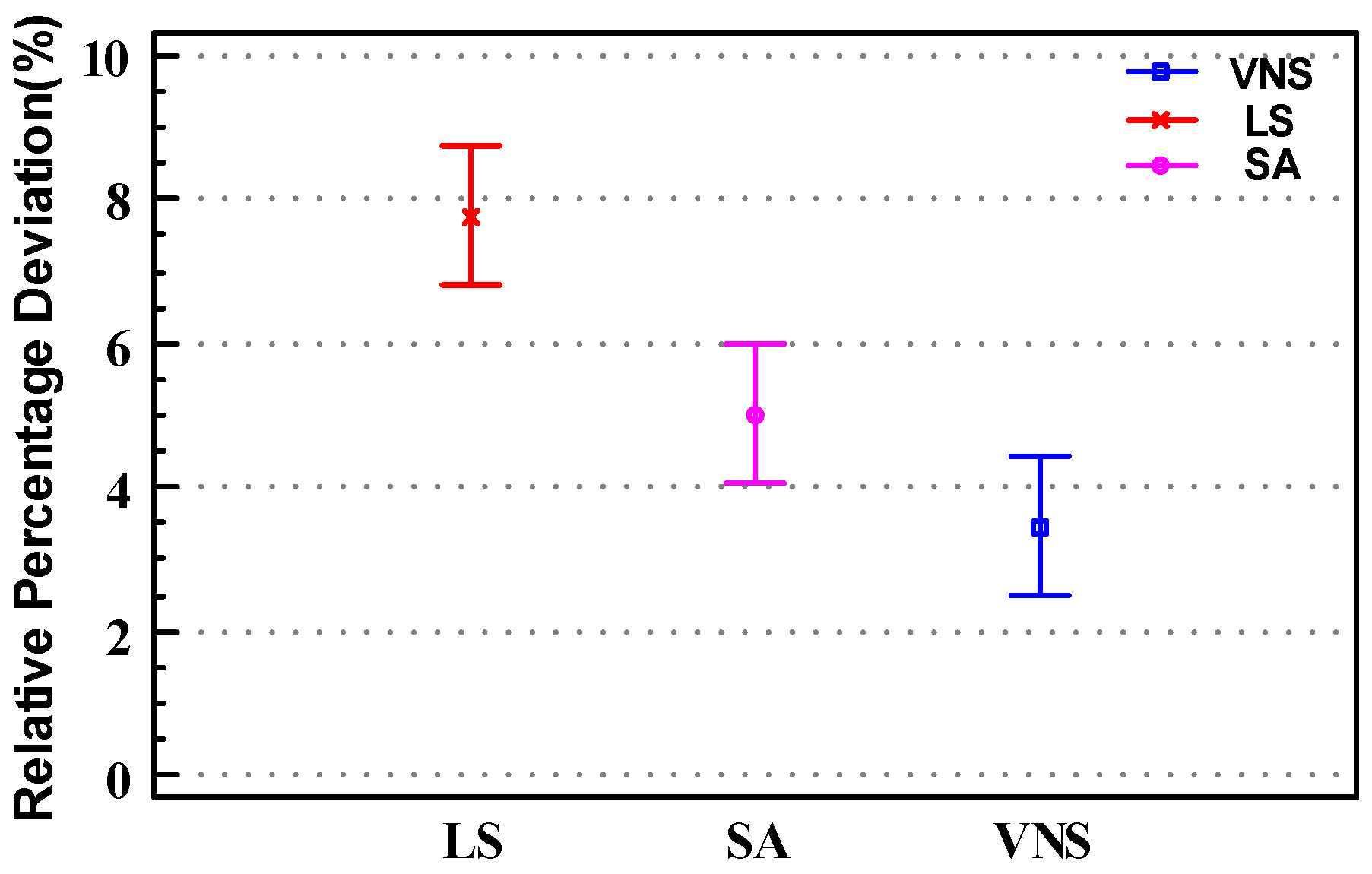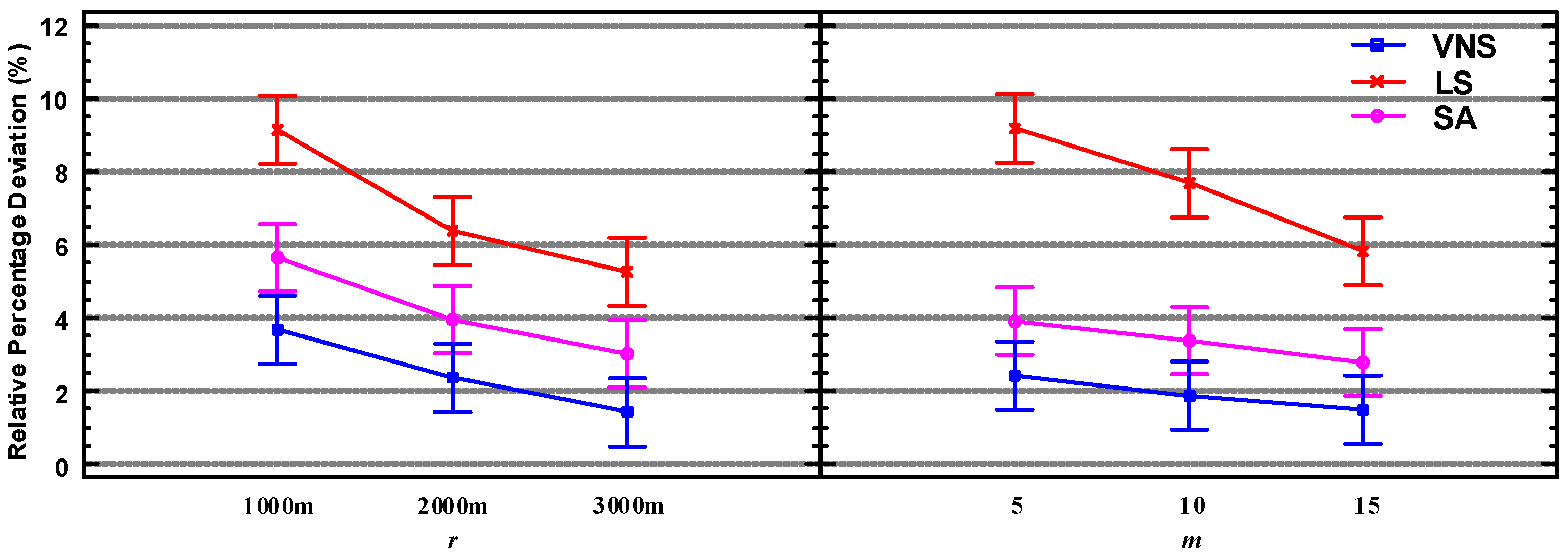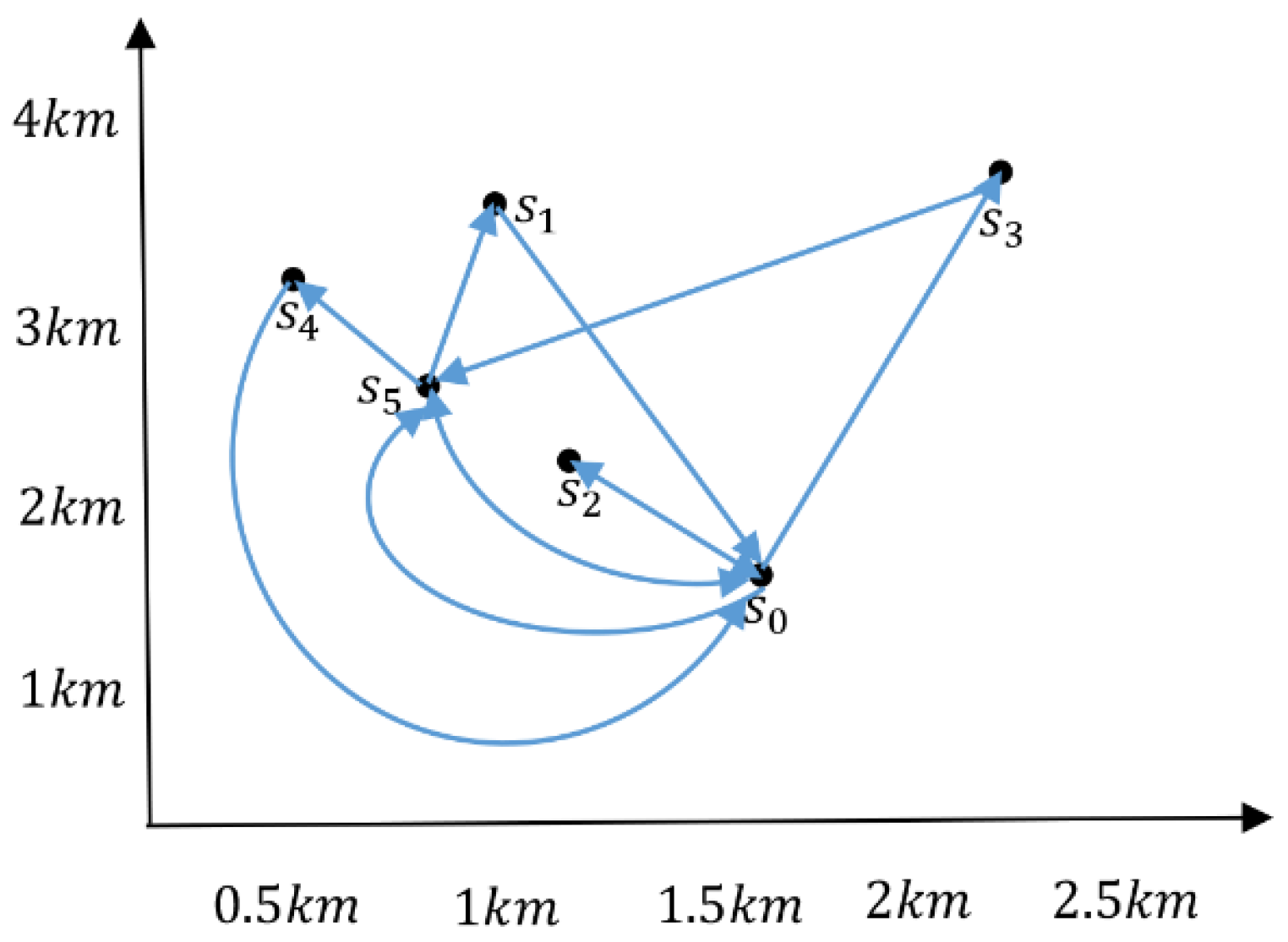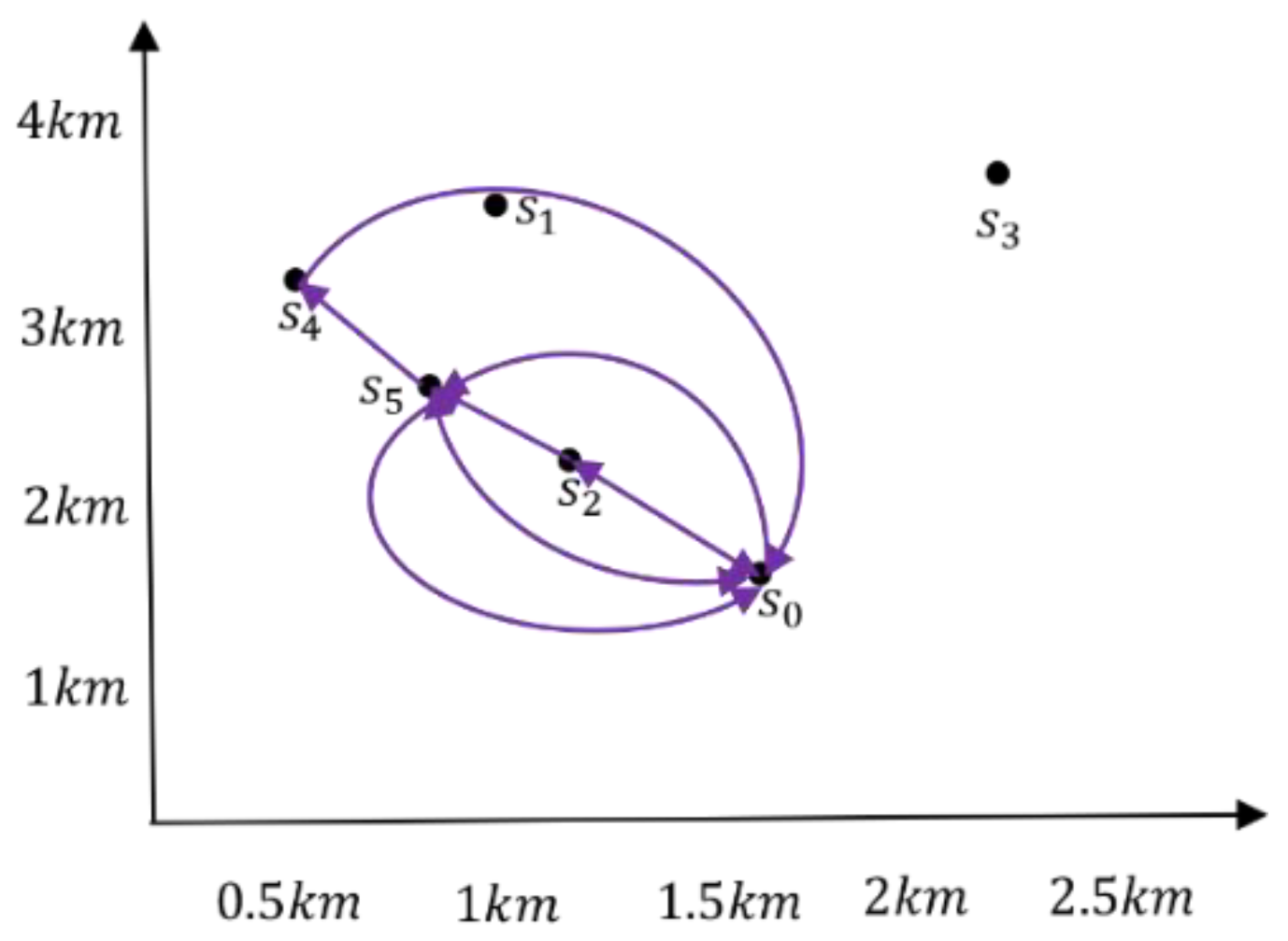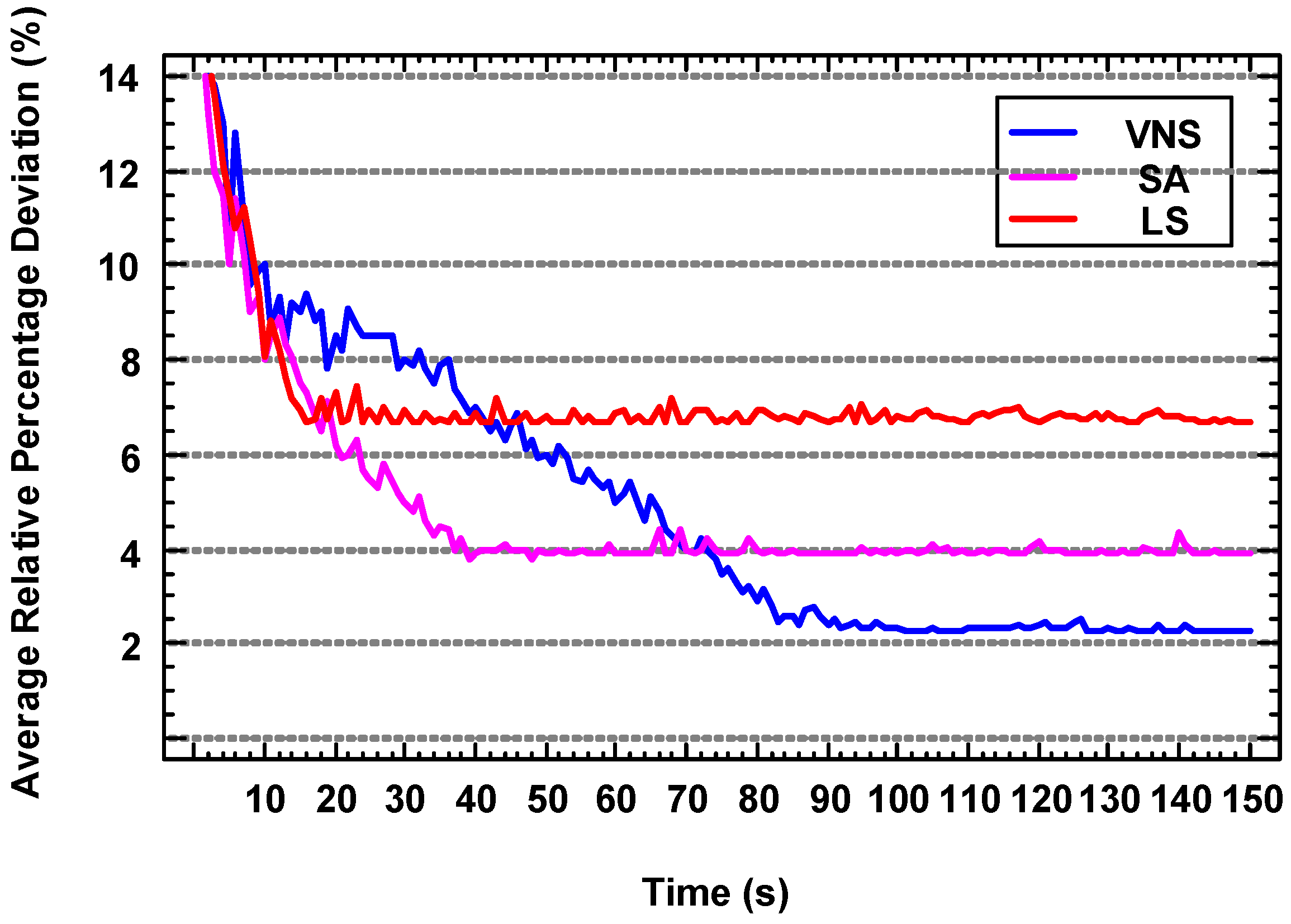Equation (13) depicts the calculation of the RPD value. In Equation (13), represents the optimal fitness for the same instances.
5.1. Parameter Calibration
The initial temperature
is critical to the performance of the SA algorithm framework. We use a large number of instances to determine the value of
. To the best of our knowledge, no uniform testing benchmark is available for the considered problem. So, we combined some practical scenarios in logistics transportation to generate test instances, such as [
22] and [
23].
Parameters are designed as follows. (i) We consider the regional parameters with the area radius and the number of stations . (ii) The weight of each package is generated randomly in interval , and the parameter represents the maximum weight of all packages. The package related parameters are set as and . (iii) The number of UAVs . The special logistic UAV is selected with maximum flight time , load capacity and average speed .
There are
instance combinations. For each instance combination, we compare the algorithm performance of five different values of initial temperature
of SA framework. Therefore, there are
instances for parameter calibration. One-way analysis of variance technique is used to analyze the experiment results. The mean plots of SA framework with different values of
are depicted in
Figure 3. The smaller RPD values, the better optimization effect.
From
Figure 3, it can be observed that the differences are statistically significant for
however, they tend to be flat for
. So, when
is set to 120, the algorithm can generate a better solution with fewer iterations.
5.2. Robustness Analysis
In terms of the parameter calibration, is set to the initial temperature of the SA algorithm framework. To further demonstrate the robustness of the proposed algorithm, we analyze the influence of the five instance parameters on this algorithm. The proposed algorithm is compared with the Local Search (LS) algorithm and the Simulated Annealing (SA) algorithm.
As can be seen from
Figure 4, the VNS performs better than the other two algorithms. The statistical difference is significant. This is because the VNS algorithm framework can compare the optimal solutions of different neighborhoods, and the final result is closer to the global optimal solution, which can effectively avoid falling into the local optimal situation.
Interactions between each parameter and the compared algorithms with 95.0 percent Tukey HSD (Honestly Significant Difference) intervals are depicted in
Figure 5 and
Figure 6. It can be concluded from
Figure 5 and
Figure 6 that the observed differences are not statistically significant for the proposed algorithm in most cases.
Figure 5 shows that the area radius
has a great effect on the performance of proposed SA algorithm framework. Furthermore, the differences in RPD values are not statistically significant for the number of express cabinet
. This is because the radius of the region directly affects the fitness of the solution. The increase of
widens the differences between these RPD values, making it easier for the algorithm to find better solutions.
Figure 6 illustrates that the following parameters: the maximum weight of packages
, the total weight of packages
G, and the number of UAVs
h have little influence on the execution of SA algorithm framework. Furthermore, their differences in RPD values are not statistically significant. This is because these three parameters hardly affect the ability of the algorithm to search for the global optimal solution.
After comparing the robustness of LS with SA, we compared SA with Variable Neighborhood Search algorithm (VNS). From
Figure 5, it can be observed that although the robustness of SA and VNS is similar, VNS optimizes the solution better especially for the following parameters: the radius of area
and the number of express cabinet
.
Figure 6 shows that the robustness of the two algorithms is not different, but VNS has better search performance. The differences in RPD values are statistically significant for the following parameters: the maximum weight of packages
and the total weight of packages
. These experiments illustrate that there is little difference in robustness between algorithms SA and VNS, but the execution performance of VNS is better. This is because VSN algorithm framework can calculate the optimal solution in different neighborhoods to avoid falling into the local optimal situation, so it can frequently get the global optimal solution.
For each of the 243 instance combinations, five different values of initial temperature
of SA framework are chosen, i.e., in total there are 1215 instances for the algorithms to compare. Average Relative Percentage Deviations (ARPDs) on all instance combinations are shown in
Table 2. This table not only shows the execution effect of different algorithms in each test instance, but it also depicts the influence of these instance parameters on different algorithms. From
Table 2, it can be illustrated that VNS has the lowest ARPDs with different parameter settings and SA has the highest ARPDs. VNS performs better than the others mainly because it can escape from the local optimum by restructuring the neighborhood, and the explored solution space is larger than the other two. From the analysis of the results, it can be seen that the proposed VNS algorithm framework is robust for most parameters.
In order to better show the structure of the result and system flow, the test based on a small-scale example is executed. The calculation results of the UAV flight tasks are described in detail.
Figure 7 shows the path scheduling results of three isomorphic UAVs in a small-scale scenario. For this type of UAV, the upper limit of load is 5 kg, the average flight speed is 48 km/h, and the total flying time of single charging is 0.67 h. In this experiment, the coordinates (abscissa/km, ordinate/km) of each express cabinet are as follows:
(1.604, 1.720),
(1.163, 3.585),
(1.220, 2.153),
(2.467, 3.623),
(0.519, 3.264),
(0.714, 2.742).
Figure 8 is the path planning diagram of UAV
1 based on the map data and the calculation results shown in
Figure 7. UAV
1 has six missions in total. The first one: it starts from
, passes
,
and
in turn, and then returns to
. The second one and the third one are both missions between
and
. The fourth one is shuttle flights between
and
. The fifth one is flight from
, passes
and
in turn, and then returns to
. The sixth one is from
, passes
and
in turn, and then returns to
. Among them, the reason that the same destination is distributed twice is that packages delivered exceed the upper load limit of the UAV.
Figure 9 is the path planning diagram of UAV
2 based on the map data and the calculation results shown in
Figure 7. As shown in
Figure 9, UAV
2 has seven missions in total. The first and the third missions both start from
, pass
and
in turn, and then return to
. The second one and the fourth one’s missions are between
and
. The fifth one is flight from
, passes
,
,
and
in turn, and then returns to
.
Figure 10 is the path planning diagram of UAV
3 based on the map data and the calculation results shown in
Figure 7. As shown in
Figure 10, UAV
3 has seven missions in total. The first, fourth, and fifth missions are flights between
, and
. The second and third missions are shuttle flights between
and
. The sixth one is flight from
, passes
,
, and then returns to
. The seventh one is flight from
, passes
,
, and then returns to
.
Since the considered problem is biobjective, we apply a linear weighted sum (LWS) method to evaluate the solutions on both the total completion time and the satisfaction perspectives, as defined as Equation (14).
and
are the weight according to the importance of the total completion time and the satisfaction, respectively. Therefore, the smaller the LWS, the better the solution will be.
As can be seen from
Figure 11, compared with no difference shown in (c), when the weight of customer satisfaction
A is higher and the weight of total completion time
B is lower, the Relative Percentage Deviation (RPD) value of Local Search (LS) algorithm is larger and the RPD value of variable neighborhood search (VNS) algorithm is smaller shown in (e). Conversely, the RPD value of LS algorithm is smaller and the RPD value of VNS algorithm is larger, shown in (a). So, LS algorithm is more suitable to solve the problem of high demand for customer satisfaction, VNS algorithm is more suitable to solve the problem of high demand for total completion time.
From
Figure 11 it is observed that when the parameter
changes, the result of SA algorithm is the most stable and there is almost no fluctuation. The result of VSN algorithm is relatively stable with small fluctuation, while the result of LS algorithm has large fluctuation, which is sensitive to the parameter, so its stability is poor. The experimental results demonstrate that VNS is feasible and effective for the considered problem.
Table 3 shows the average operation times for the three specifications of radius of area
.
Figure 12 shows the convergence curves of the three algorithms LS, SA, and VNS simultaneously. The horizontal coordinate is the run time and the vertical coordinate is the ARPD value. From
Figure 12 it is observed that LS has the fastest convergence, SA is second, and VNS has the slowest convergence, but VNS outputs the best results. Since it can escape from the local optimum by changing the neighborhood, it is possible to find a better solution compared with LS and SA. However, constant changes of neighborhood increase its cost of time.
Based on the above experimental results and analysis, we determine that VNS performs better than the other two which are the most commonly used heuristics for optimization problems, although it converges the slowest. VNS is easy to implement and it can balance very well between diversity and convergence. We believe that there are many other metaheuristics which are suitable for solving the problem and may have better performance. Based on our preparatory work, GA and PSO converge slowly and their performances on TSP are good for small-size testing instances. If the computation time is not limited, we believe they can find better solutions than those of VNS in probability significance. NSGA-II is another potentially competitive algorithm which may be very suitable for the considered problem, since NSGA-II converges faster than GA and PSO and has promising performance on multiobjective optimization problems. We will further investigate these algorithms to improve our work on the considered problem based on these assumptions.
